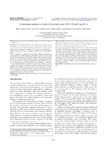Multivariate analysis of indirect free kick in the FIFA World Cup 2014

View/
Use this link to cite
http://hdl.handle.net/2183/36234
Except where otherwise noted, this item's license is described as Atribución-NoComercial-SinDerivadas 4.0 Internacional
Collections
- Investigación (CCDEF) [298]
Metadata
Show full item recordTitle
Multivariate analysis of indirect free kick in the FIFA World Cup 2014Date
2017-10Citation
Maneiro, R., Losada López, J. L., Casal Sanjurjo, C. A., & Ardá Suárez, A. (2017). Multivariate analysis of indirect free kick in the FIFA World Cup 2014. Anales de Psicología, 2017, vol. 33, num. 3, p. 461-470.
Abstract
[Resumen] Los tiros libres indirectos son situaciones que se producen con regularidad durante los partidos de fútbol, siendo acciones potencialmente trascendentales en el resultado final de los partidos. Los objetivos de este estudio fueron determinar la efectividad de estas acciones, identificar las va-riables asociadas con el éxito y proponer un modelo de tiro libre indirecto exitoso.
Fueron codificados y analizados 506 tiros libres indirectos registrados en los 64 partidos de la FIFA World Cup Brasil 2014, se llevaron a cabo análi-sis univariados, bivariados (Ji-Cuadrado) y multivariados (regresión logística binaria), los resultados indican una baja eficacia en el remate, remate entre los tres palos y el gol en este tipo de acciones. En cambio, el 89% de los go-les con procedencia en un tiro libre indirecto han contribuido a sumar pun-tos en el resultado final de los partidos. La organización ofensiva, basada en maniobras de creación y ocupación de espacios, y la intervención de hasta 4 jugadores, son variables que se han revelado como moduladoras de la efica-cia. Sin duda, estos enunciados podrían suponer un punto de partida para dotar a entrenadores de nuevas herramientas tácticas con el fin de dotar de un perfil más eficaz en este tipo de acciones. [Abstract] Indirect free kicks are relatively common in soccer and have the potential to change the outcome of a match. The aim of this study was to determine the effectiveness of these kicks, to identify variables associated with success, and propose a model for optimal execution.
We analyzed and coded 506 indirect free kicks taken in 64 matches during the FIFA 2014 World Cup in Brazil and conducted univariate, bivariate (chi-square), and multivariate (binary logistic regression) analyses. Our re-sults show very low success rates in terms of shots, shots between the posts, and goals. Nevertheless, 89% of goals scored from indirect free kicks led to the teams gaining valuable points. Determinants of success included a dynamic attack based on the creation and occupation of spaces and the intervention of up to four attackers. Our findings offer an interesting start-ing point for trainers to build on tactical strategies designed to improve free-kick performance.
Keywords
Regresión logística
Metodología observacional
Fútbol
Saque de esquina
Logistic regression
Observational methodology
Soccer
Corner
Metodología observacional
Fútbol
Saque de esquina
Logistic regression
Observational methodology
Soccer
Corner
Editor version
Rights
Atribución-NoComercial-SinDerivadas 4.0 Internacional
ISSN
0212-9728.






